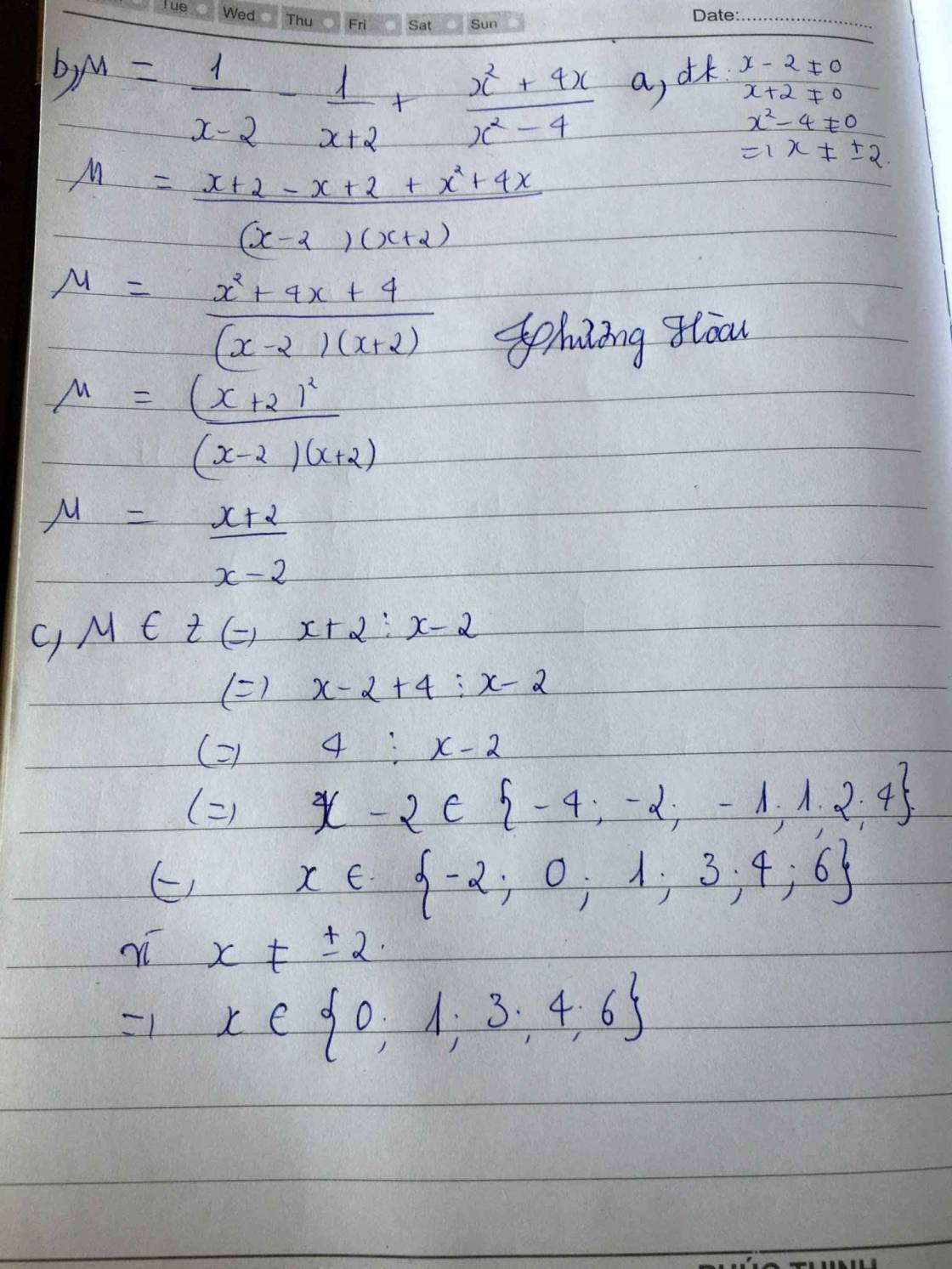Cho biểu thức M = \(\dfrac{x^2-5}{x^2-2}\), x ∈ Z . tìm các giá trị nguyên của x để M là số nguyên

Những câu hỏi liên quan
Cho biểu thức M = x^2 - 5 / x^2 - 2 ( x thuộc Z) . Tìm x thuộc Z để M có giá trị là số nguyên.
ta có: \(M=\frac{x^2-5}{x^2-2}=\frac{x^2-2-3}{x^2-2}=1-\frac{3}{x^2-2}\)
Để M có giá trị nguyên
=> 3/x^2 - 2 thuộc Z
=> 3 chia hết cho x^2 - 2
=> x^2-2 thuộc Ư(3)={1;-1;3;-3}
nếu x^2-2 = 1 => x^2 = 3 \(\Rightarrow x=\sqrt{3};x=-\sqrt{3}\) (Loại)
x^2-2 = -1 => x^2 = 1 => x = 1 hoặc x = -1 (TM)
x^2-2 = 3 => x^2 = 5 \(\Rightarrow x=\sqrt{5};x=-\sqrt{5}\) (Loại)
x^2-2 = -3 => x^2 = -1 => không tìm được x
KL:...
Đúng 0
Bình luận (0)
bài 13 cho M=\(\dfrac{1}{x-2}-\dfrac{1}{x+2}+\dfrac{x^2+4x}{x^2-4}\)
a,tìm điều kiện xác định của biểu thức M
b,rút gọn M
c, tìm các giá trị nguyên của a để M nhận giá trị nguyên
a)
\(ĐKXĐ:\left\{{}\begin{matrix}x-2\ne0\\x+2\ne0\\x^2-4\ne0\end{matrix}\right.< =>\left\{{}\begin{matrix}x\ne2\\x\ne-2\end{matrix}\right.\)
b)
\(\dfrac{1}{x-2}-\dfrac{1}{x+2}+\dfrac{x^2+4x}{x^2-4}\)
\(=\dfrac{1}{x-2}-\dfrac{1}{x+2}+\dfrac{x\left(x+4\right)}{\left(x-2\right)\left(x+2\right)}\)
\(=\dfrac{x+2}{\left(x-2\right)\left(x+2\right)}-\dfrac{x-2}{\left(x-2\right)\left(x+2\right)}+\dfrac{x\left(x+4\right)}{\left(x-2\right)\left(x+2\right)}\)
\(=\dfrac{x+2-x+2+x^2+4x}{\left(x-2\right)\left(x+2\right)}\)
\(=\dfrac{x^2+4x+4}{\left(x-2\right)\left(x+2\right)}\\ =\dfrac{\left(x+2\right)^2}{\left(x-2\right)\left(x+2\right)}\\ =\dfrac{x+2}{x-2}\)
c)
\(\dfrac{x+2}{x-2}=\dfrac{x-2+4}{x-2}=\dfrac{x-2}{x-2}+\dfrac{4}{x-2}=1+\dfrac{4}{x-2}\)
vậy M nhận giá trị nguyên thì 4⋮x-2
=> x-2 thuộc ước của 4
\(Ư\left(4\right)\in\left\{-1;1;-2;2;;4;-4\right\}\)
ta có bảng sau
| x-2 | -1 | 1 | -2 | 2 | 4 | -4 |
| x | 1(tm) | 3(tm) | 0(tm) | 4(tm) | 6(tm | -2(loại) |
Đúng 2
Bình luận (0)
a) Tìm các giá trị nguyên của x để biểu thức Mdfrac{8x+1}{4x-1}nhận giá trị nguyênb) Tìm giá trị nguyên của biến x để biểu thức Adfrac{5}{4-x}có giá trị lớn nhấtc) Tìm giá trị nguyên của biến x để biểu thức Bdfrac{8-x}{x-3}có giá trị nhỏ nhất(Hơi khó mọi người giúp mình với ạ)
Đọc tiếp
a) Tìm các giá trị nguyên của \(x\) để biểu thức M=\(\dfrac{8x+1}{4x-1}\)nhận giá trị nguyên
b) Tìm giá trị nguyên của biến \(x\) để biểu thức \(A=\dfrac{5}{4-x}\)có giá trị lớn nhất
c) Tìm giá trị nguyên của biến \(x\) để biểu thức \(B=\dfrac{8-x}{x-3}\)có giá trị nhỏ nhất
(Hơi khó mọi người giúp mình với ạ)
a) Ta có: \(M=\dfrac{8x+1}{4x-5}=\dfrac{8x-10+11}{4x-5}=\dfrac{2\left(x-5\right)+11}{4x-5}=2+\dfrac{11}{4x-5}\)
Để M nhận giá trị nguyên thì \(2+\dfrac{11}{4x-5}\) nhận giá trị nguyên
\(\Rightarrow\dfrac{11}{4x-5}\) nhận giá trị nguyên
\(\Rightarrow11⋮4x-5\)
Vì \(x\in Z\) nên \(4x-5\in Z\)
\(\Rightarrow4x-5\inƯ\left(11\right)=\left\{\pm1;\pm11\right\}\)
\(\Rightarrow x\in\left\{1;\pm1,5;4\right\}\)
Vậy \(x\in\left\{1;4\right\}\) thỏa mãn \(x\in Z\).
b) Ta có: \(A=\dfrac{5}{4-x}\). ĐK: \(x\ne4\)
Nếu 4 - x < 0 thì x > 4 \(\Rightarrow A>0\)
4 - x > 0 thì x < 4 \(\Rightarrow A< 0\)
Để A đạt GTLN thì 4 - x là số nguyên dương nhỏ nhất
\(\Rightarrow4-x=1\Rightarrow x=3\)
\(\Rightarrow A=\dfrac{5}{4-3}=5\)
Vậy MaxA = 5 tại x = 3
c) \(B=\dfrac{8-x}{x-3}\). ĐK: \(x\ne3\).
Ta có: \(B=\dfrac{8-x}{x-3}=\dfrac{-\left(x-8\right)}{x-3}=\dfrac{-\left(x-3\right)+5}{x-3}=\dfrac{5}{x-3}-1\)
Để B đạt giá trị nhỏ nhất thì \(\dfrac{5}{x-3}-1\) nhỏ nhất
\(\Rightarrow\dfrac{5}{x-3}\) nhỏ nhất
Nếu x - 3 > 0 thì x > 3 \(\Rightarrow\dfrac{5}{x-3}>0\)
x - 3 < 0 thì x < 3 \(\Rightarrow\dfrac{5}{x-3}< 0\)
Để \(\dfrac{5}{x-3}\) nhỏ nhất thì x - 3 là số nguyên âm lớn nhất
\(\Rightarrow x-3=-1\Rightarrow x=2\)
\(\Rightarrow B=\dfrac{8-2}{2-3}=-6\)
Vậy MaxB = -6 tại x = 2.
Đúng 1
Bình luận (1)
a) Để M nhận giá trị nguyên thì \(8x+1⋮4x-1\)
\(\Leftrightarrow8x-2+3⋮4x-1\)
mà \(8x-2⋮4x-1\)
nên \(3⋮4x-1\)
\(\Leftrightarrow4x-1\inƯ\left(3\right)\)
\(\Leftrightarrow4x-1\in\left\{1;-1;3;-3\right\}\)
\(\Leftrightarrow4x\in\left\{2;0;4;-2\right\}\)
\(\Leftrightarrow x\in\left\{\dfrac{1}{2};0;1;-\dfrac{1}{2}\right\}\)
mà x là số nguyên
nên \(x\in\left\{0;1\right\}\)
Vậy: \(x\in\left\{0;1\right\}\)
Đúng 0
Bình luận (0)
Cho biểu thức \(M=\dfrac{2\sqrt{x}+1}{\sqrt{x}-3}\), tìm giá trị nguyên của x để biểu thức M đạt giá trị nguyên.
Lời giải:
$M=\frac{2(\sqrt{x}-3)+7}{\sqrt{x}-3}=2+\frac{7}{\sqrt{x}-3}$
Để $M$ nguyên thì $\frac{7}{\sqrt{x}-3}$
Với $x$ nguyên không âm thì điều này xảy ra khi mà $\sqrt{x}-3$ là ước của $7$
$\Rightarrow \sqrt{x}-3\in\left\{\pm 1; \pm 7\right\}$
$\Rightarrow \sqrt{x}\in \left\{4; 2; 10; -4\right\}$
Vì $\sqrt{x}\geq 0$ nên $\sqrt{x}\in \left\{4; 2; 10\right\}$
$\Rightarrow x\in \left\{16; 4; 100\right\}$ (tm)
Đúng 1
Bình luận (0)
Cho biểu thức:A=\(\dfrac{2x-1}{x+2}\)
a) Tìm số nguyên x để biểu thức A là phân số
b)Tìm các số nguyên x để biểu thức A có giá trị là 1 số nguyên
c)Tìm các số nguyên x để biểu thức A đạt giá trị lớn nhất,giá trị nhỏ nhất
A = \(\dfrac{2x-1}{x+2}\)
a, A là phân số ⇔ \(x\) + 2 # 0 ⇒ \(x\) # -2
b, Để A là một số nguyên thì 2\(x-1\) ⋮ \(x\) + 2
⇒ 2\(x\) + 4 - 5 ⋮ \(x\) + 2
⇒ 2(\(x\) + 2) - 5 ⋮ \(x\) + 2
⇒ 5 ⋮ \(x\) + 2
⇒ \(x\) + 2 \(\in\) { -5; -1; 1; 5}
⇒ \(x\) \(\in\) { -7; -3; -1; 3}
c, A = \(\dfrac{2x-1}{x+2}\)
A = 2 - \(\dfrac{5}{x+2}\)
Với \(x\) \(\in\) Z và \(x\) < -3 ta có
\(x\) + 2 < - 3 + 2 = -1
⇒ \(\dfrac{5}{x+2}\) > \(\dfrac{5}{-1}\) = -5 ⇒ - \(\dfrac{5}{x+2}\)< 5
⇒ 2 - \(\dfrac{5}{x+2}\) < 2 + 5 = 7 ⇒ A < 7 (1)
Với \(x\) > -3; \(x\) # - 2; \(x\in\) Z ⇒ \(x\) ≥ -1 ⇒ \(x\) + 2 ≥ -1 + 2 = 1
\(\dfrac{5}{x+2}\) > 0 ⇒ - \(\dfrac{5}{x+2}\) < 0 ⇒ 2 - \(\dfrac{5}{x+2}\) < 2 (2)
Với \(x=-3\) ⇒ A = 2 - \(\dfrac{5}{-3+2}\) = 7 (3)
Kết hợp (1); (2) và(3) ta có A(max) = 7 ⇔ \(x\) = -3
Đúng 1
Bình luận (0)
Bài 2: Cho biểu thức: D= 1 x+4 + x x-4 + (24 - x ^ 2)/(x ^ 2 - 16) * voi x ne pm4.
1) Chứng minh D= 5/(x - 4) *
2) Tính giá trị của biểu thức Dtaix = 10
3) Cho M = (x-2).D. Tìm các số tự nhiên x để giá trị của biểu thức M là số nguyên.
Bài 2: Cho biểu thức: D= 1 x+4 + x x-4 + (24 - x ^ 2)/(x ^ 2 - 16) * voi x ne pm4.
1) Chứng minh D= 5/(x - 4) *
2) Tính giá trị của biểu thức Dtaix = 10
3) Cho M = (x-2).D. Tìm các số tự nhiên x để giá trị của biểu thức M là số nguyên.
1: \(D=\dfrac{1}{x+4}+\dfrac{x}{x-4}+\dfrac{24-x^2}{x^2-16}\)
\(=\dfrac{1}{x+4}+\dfrac{x}{x-4}+\dfrac{24-x^2}{\left(x+4\right)\left(x-4\right)}\)
\(=\dfrac{x-4+x\left(x+4\right)+24-x^2}{\left(x+4\right)\left(x-4\right)}\)
\(=\dfrac{-x^2+x+20+x^2+4x}{\left(x+4\right)\left(x-4\right)}=\dfrac{5x+20}{\left(x+4\right)\left(x-4\right)}\)
\(=\dfrac{5\left(x+4\right)}{\left(x+4\right)\left(x-4\right)}=\dfrac{5}{x-4}\)
2: Khi x=10 thì \(D=\dfrac{5}{10-4}=\dfrac{5}{6}\)
3: \(M=\left(x-2\right)\cdot D=\dfrac{5\left(x-2\right)}{x-4}\)
Để M là số nguyên thì \(5\cdot\left(x-2\right)⋮x-4\)
=>\(5\left(x-4+2\right)⋮x-4\)
=>\(5\left(x-4\right)+10⋮x-4\)
=>\(10⋮x-4\)
=>\(x-4\in\left\{1;-1;2;-2;5;-5;10;-10\right\}\)
=>\(x\in\left\{5;3;6;2;9;-1;14;-6\right\}\)
Đúng 2
Bình luận (0)
Cho biểu thức M = \(\dfrac{x+1}{x-2}\)và N = \(\dfrac{x+1}{x-3}\)- \(\dfrac{2}{x-3}\)+ \(\dfrac{5x+3}{x^2-9}\)
a) Rút gọn N
b) Tìm các giá trị nguyên của x để P = M.N nhận giá trị nguyên
Cho biểu thức
M=căn x +1/2
A)Tìm các giá trị nguyên của x để M nhận giá trị nguyên
B)Tìm giá trị lớn nhất của biểu thức M
c)Tìm các giá trị nguyên của x để A nhận giá trị nguyên
Bài 5. Cho biểu thức: C = \(\dfrac{2\sqrt{x}-3}{\sqrt{x}-2}\) 𝑣ớ𝑖 𝑥 ≥ 0; 𝑥 ≠ 4. Tìm x nguyên để C đạt giá trị nguyên nhỏ nhất
Bài 6. Cho biểu thức: D = \(\dfrac{x-3}{\sqrt{x}+1}\) với 𝑥 ≥ 0; 𝑥 ≠ 1. Tìm x nguyên để D có giá trị là số nguyên
Bài 5:
\(C=\frac{2\sqrt{x}-3}{\sqrt{x}-2}=\frac{2(\sqrt{x}-2)+1}{\sqrt{x}-2}=2+\frac{1}{\sqrt{x}-2}\)
Để $C$ nguyên nhỏ nhất thì $\frac{1}{\sqrt{x}-2}$ là số nguyên nhỏ nhất.
$\Rightarrow \sqrt{x}-2$ là ước nguyên âm lớn nhất
$\Rightarrow \sqrt{x}-2=-1$
$\Leftrightarrow x=1$ (thỏa mãn đkxđ)
Đúng 0
Bình luận (0)
Bài 6:
$D(\sqrt{x}+1)=x-3$
$D^2(x+2\sqrt{x}+1)=(x-3)^2$
$2D^2\sqrt{x}=(x-3)^2-D^2(x+1)$ nguyên
Với $x$ nguyên ta suy ra $\Rightarrow D=0$ hoặc $\sqrt{x}$ nguyên
Với $D=0\Leftrightarrow x=3$ (tm)
Với $\sqrt{x}$ nguyên:
$D=\frac{(x-1)-2}{\sqrt{x}+1}=\sqrt{x}-1-\frac{2}{\sqrt{x}+1}$
$D$ nguyên khi $\sqrt{x}+1$ là ước của $2$
$\Rightarrow \sqrt{x}+1\in\left\{1;2\right\}$
$\Leftrightarrow x=0; 1$
Vì $x\neq 1$ nên $x=0$.
Vậy $x=0; 3$
Đúng 0
Bình luận (0)
Bài 6:
Để D nguyên thì \(x-3⋮\sqrt{x}+1\)
\(\Leftrightarrow\sqrt{x}+1\in\left\{1;2\right\}\)
\(\Leftrightarrow\sqrt{x}\in\left\{0;1\right\}\)
hay \(x\in\left\{0;1\right\}\)
Đúng 0
Bình luận (0)






















